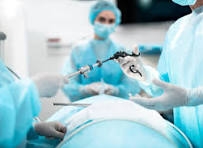New Invasive Procedure

Invasive procedures are medical interventions that involve entering the body, either through a natural opening or through an incision. They can range from relatively minor procedures to major surgeries, and their complexity and risk levels can vary widely. Here's a general overview:
### Types of Invasive Procedures
1. **Diagnostic Procedures**: These are used to diagnose conditions and include procedures like biopsies (where a small sample of tissue is taken for analysis) and endoscopies (where a flexible tube with a camera is used to view internal organs).
2. **Surgical Procedures**: These involve operating on the body to treat or manage medical conditions. Examples include appendectomies, where the appendix is removed, and coronary artery bypass surgeries.
3. **Therapeutic Procedures**: These are performed to treat specific conditions and include things like catheter insertions for administering medication or fluids, and certain types of minimally invasive surgeries like laparoscopic surgery, where small incisions and specialized instruments are used.
4. **Interventional Radiology Procedures**: These involve using imaging techniques to guide minimally invasive procedures. Examples include angioplasty (to open blocked blood vessels) and stent placements.
### Risks and Considerations
- **Infection**: Any invasive procedure carries a risk of infection at the site of entry or internally.
- **Bleeding**: Some procedures may cause internal bleeding or damage to blood vessels.
- **Recovery Time**: Recovery times can vary based on the procedure's complexity, from a few days to several weeks or more.
- **Complications**: Depending on the procedure, complications might include reactions to anesthesia, damage to surrounding tissues, or unintended effects.
### Benefits
- **Diagnosis and Treatment**: Invasive procedures can provide critical information for diagnosis and offer effective treatment options that might not be available through non-invasive methods.
- **Precision**: Many invasive procedures are highly precise and can target specific areas, which can minimize damage to surrounding tissues.
- **Improved Outcomes**: For many conditions, invasive procedures can lead to better outcomes and quicker resolution than conservative treatments.
### Aftercare
Proper aftercare is crucial for recovery and minimizing risks. This might include:
- **Monitoring**: Regular check-ups to monitor recovery and catch any complications early.
- **Wound Care**: Keeping any incisions clean and dry to prevent infection.
- **Follow-up Treatments**: Depending on the procedure, additional treatments or medications may be required.
### Conclusion
Invasive procedures can be essential for diagnosing and treating various medical conditions. While they come with risks, advancements in technology and techniques have significantly improved safety and outcomes. Always consult with a healthcare professional to understand the necessity, risks, and benefits of any invasive procedure.
- Industry
- Art
- Causes
- Crafts
- Dance
- Drinks
- Film
- Fitness
- Food
- Games
- Gardening
- Health
- Home
- Literature
- Music
- Networking
- Other
- Party
- Religion
- Shopping
- Sports
- Theater
- Wellness
- News


